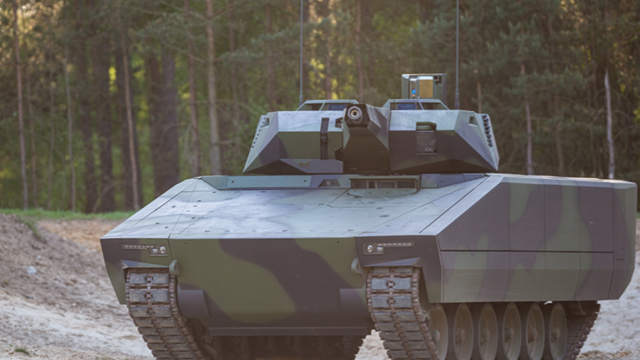Seen in the crush of combat, or driving down a street, any observer could be forgiven for thinking a Rheinmetall Lynx is a tank. The tracked vehicle is armoured and turreted, and it was built by the German arms giant as a way to counter new developments in Russian armoured vehicles in the 2010s. February 2022 saw the introduction of the Lynx 120mm, which sports a main gun as big and powerful as that of a proper battle tank. Understanding the Lynx is a way to glimpse the last decade of thinking about medium armour, the vehicles designed for all but the heaviest fighting on the ground.
The Lynx, at least initially, was offered in Infantry Fighting Vehicle form. That’s a sort of hybrid category, which best describes the Bradley series of tracked, turreted, and armoured transports in the United States. Built to replace a lightly armed Vietnam-era transport, the Bradley shed about half its passenger capacity, but gained a set of powerful weapons. This process became the dark comedic heart of 1998’s HBO film The Pentagon Wars, though high-profile criticism and satire wasn’t enough to abandon the Pentagon’s plans for transports that can out-fight other transports.
One reason for the durability of IFVs is that the platforms can be adapted to a bunch of useful forms. Ultimately, what drew my eye to the Lynx was a display in Australia of a couple variants:
Lynx IFV and Lynx Combat support CSV vehicle from @RheinmetallAG the other contender for @AustralianArmy Land 400 phase 3 program. The IFV has a Lance turret used on the Boxer CRV and the CSV has a 5t vehicle-mounted telescopic crane from Supashock Defence @AvalonAIA #Avalon2023 pic.twitter.com/n0656NW9MX
— Tim Fish (@sweeneygov) March 1, 2023
The IFV version is the Infantry Fighting Vehicle — in other words, a troop transport plus gun. In the initial model, it takes a crew of three to operate, and can seat six passengers in the back. The version on display in Australia had room for 8 passengers. The turret can either fit two crew or be operated entirely remotely. In the combat support vehicle (CSV) option, the Lynx trades weapons for utility tools, in this case a crane. While not as flashy or dramatic as a weapon, the ability to bring armoured cranes to combat improves the odds of recovering vehicles that are merely damaged or stuck, letting mechanics work to help them fight another day.
With all the passenger space inside the default Lynx, that room can also be adapted to fit a mobile command centre, bristling with screens and communication nodes, as commanders in the field move within armour to direct the fight in or near the front. These vehicles are all fundamentally vulnerable to direct hits from enemy tanks or aircraft, but the armour is still built up to NATO standards against 25mm armour-piercing shells, fired from half a kilometre away or more.
The first Infantry Fighting Vehicles were drawn for the expected reality of combat in Europe in the late Cold War, where it was assumed that the USSR would advance with a massive amount of tanks and artillery through West Germany. In these conditions, transports needed to be able to fight as they moved, and then ensure that the infantry inside could keep fighting from favourable terrain. This was, like all Cold War warplanning, a deep exercise in trying to win a war that nuclear weapons were expected to end. Still, the armoured vehicles were at least a nod to the danger from battlefield use of nuclear weapons, with the armour protecting inhabitants enough to keep fighting through irradiated battlefields, at least for a little bit.
Today, these kinds of vehicles have seen action in counter-insurgencies, and especially in the war in Ukraine, where the ability of armour to move over uneven ground (especially after mud season) will likely shape how Ukraine fares against the continuing Russian invasion in 2023.
As foreign-supplied tanks join the ranks of Ukrainian forces, they are joined by armoured vehicles like Bradleys and possibly the Lynx as well. Armoured transports require more sophisticated countermeasures to stop than what most infantry has as a baseline, and while the armour isn’t as heavy as that of truly dedicated tanks, the mobility ensures soldiers on the move are much safer from artillery fire than they would be if caught in the open.
The ability to resume the same hull shape and basic features for other tools, from scout models to the tank-hunting heavy barreled version, mark the Lynx specifically and the IFV broadly as the kind of armour militaries can use for most purposes, bolstering reach and numbers without needed the dedicated resources for heavy tank operations. Lighter IFVs can more easily cross temporary and mobile bridges, and at faster speeds than tanks.
Marketed at the United States, Rhenimetall is competing for the Optionally Manned Infantry Fighting Vehicle (OMFV), built on the Lynx body. This version of the vehicle can still operate as a transport and with a two-person crew, but it could also be configured as a wholly uncrewed vehicle, remotely ordered into battle and directed from afar.
Watch a video about the Lynx OMFV below:
